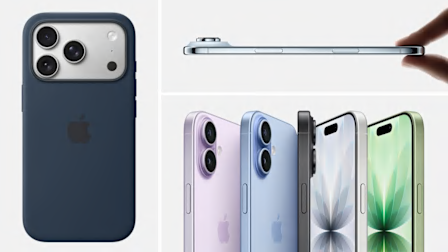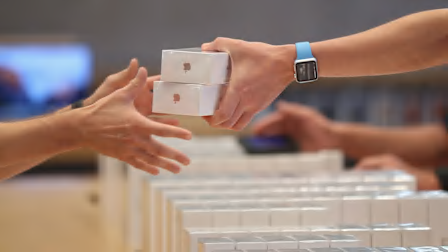Review: Samsung Galaxy S23, S23+, and S23 Ultra
The S23 Ultra packs a massive 200MP camera, while the upgrades for the Galaxy S23 and S23+ are more modest. All three perform well in CR's tests.

Samsung’s Galaxy S23, S23+, and S23 Ultra come with the incremental improvements we’ve come to expect for high-end phones: a new processor, battery upgrades, and fancy camera tricks.
The one real head-turner—and it’s a big one—is the new 200-megapixel sensor on the Galaxy S23 Ultra’s main camera. That nearly doubles the pixel count of the 108-megapixel camera on the S22 Ultra, which until now held megapixel supremacy among phones available in the U.S. What do more megapixels get you? More on that in a bit.
Cameras
The S23 and S23+ have the same triple rear-camera system as last year’s models: a 50-megapixel primary shooter, 12-megapixel ultrawide, and 10-megapixel telephoto with 2x optical zoom and up to 30x digital zoom. Like their predecessors, both phones are highly rated by CR’s testers for still image quality.
There are a few front camera and video updates, which we’ll get to in a bit, but for now, let’s focus on the S23 Ultra and its whopping 200-megapixel shooter.
It may seem like a gimmick to pack in 200 million pixels when the cameras in the iPhone 14 Pro and 14 Pro Max have less than a quarter of that (48 megapixels) and rank among the top smartphone cameras in CR’s ratings.
More megapixels doesn’t always mean better picture quality, especially with the small sensors in phone cameras. But by harnessing the software improvements and a technology called pixel binning (combining multiple pixels into one super-pixel), the camera can capture more accurate color and detail, even in poor lighting situations, Samsung says.
The leap in resolution means you can print larger images (even perhaps a billboard-sized photo of a cat) and maintain detail when you crop.
CR testers say the main camera on the S23 Ultra is the best among competing smartphones when it comes to capturing still images. In the lab, our technicians evaluate resolution, dynamic range, color accuracy, and visual noise in both standard and low-light conditions.
Here are some samples from my more informal use of the camera. Recent Galaxy S series phone cameras shoot at 12 megapixels by default, which saves on storage. But I switched my S21 Ultra to the max setting of 108 megapixels (the same as on the S22 Ultra) and the S23 Ultra to 200 megapixels, and went out to take some pictures.
They look pretty similar at first glance, although the colors pop a bit more on the S23 Ultra (right).

Photo: Melanie Pinola/Consumer Reports Photo: Melanie Pinola/Consumer Reports
But when you crop in, the S23 Ultra clearly captured more details in the architectural flourishes at Grand Central Terminal in New York City.

Photo: Melanie Pinola/Consumer Reports Photo: Melanie Pinola/Consumer Reports
As with its predecessor, the S23 Ultra also has two 10-megapixel zoom cameras—one with 3x optical zoom and the other with 10x optical zoom, which, combined with the phone’s software, supports up to 100x digital zoom.
In addition to the new 200-megapixel resolution and the default 12-megapixel setting, the S23 Ultra now offers a 50-megapixel option on the main camera. The S23 and S23+ have this, too. It’s sort of a happy medium between the most highly detailed shots and those that don’t require much storage space on your phone. (A 12-megapixel photo takes up about 4 megabytes, a 50-megapixel about 8MB, and a 200-megapixel one around 30MB.)
Samsung typically includes some nifty photo tricks with its new phones, and one of the most promising this year is Astrophoto, which lets you capture faint stars and constellations in the night sky. As with a DSLR camera or a third-party astrophotography app, you’ll need a tripod.
I couldn’t snap images of celestial bodies in my suburban backyard, thanks to clouds and light pollution, but I was able to point the phone at the sky—and even a wall indoors—and summon a map of constellations that are light-years away. It’s a neat, built-in party trick.
Videos and Selfies
All three phones can now shoot 8K video at 30 frames per second (fps), up from last year’s 24 fps. A higher frame rate results in smoother videos, but you need an 8K monitor or television to see the full effect. (Because there’s little 8K video content available, it might not be worth upgrading your TV or monitor just for home movies.)
The front selfie camera on each model can now capture 4K video at 60 fps, with a more gradual background blur or bokeh effect. That might make some TikTok creators happy.
That camera now measures 12 megapixels—up from 10 megapixels on the two smaller models, but a dip from 40 megapixels on the Ultra.
The S23 series models are all top-rated for video quality and front selfie quality, in addition to the impressive still image quality.
Battery and Display
When the phones debuted, Samsung said that, thanks to the new, more energy-efficient chipset, all three models would have longer battery life—including the S23 Ultra, which has the same 5,000-milliamp-hour battery as the S22 Ultra—and that claim is true.
The S23 and S23+ both received a 200mAh increase in battery capacity: The battery in the S23 now measures 3,900mAh and the S23+ 4,700mAh.
In our labs, the S23 lasted 36.5 hours on one charge compared with the S22’s 25 hours; the S23+ logged 40.5 hours compared with the S22’s 31 hours; and the S23 Ultra had the longest battery life of the bunch, 45 hours, compared with the S22’s 35 hours.
Samsung also says it has improved its automatic Vision Booster feature to increase the tone and visibility of the screens under direct sunlight. It works very well, in my experience, seamlessly transitioning from indoors to outdoors; when you compare phones with and without the Vision Booster side-by-side, the difference is stark.
For the first time, the S23 base model can reach the same brightness level as its siblings, closing the gap at least slightly between it and the more premium options.
Design
The camera housing bump that once surrounded the lenses on the back of earlier models is now gone; the new phones have cutouts for each camera instead, giving them a more streamlined look. And if you forgo a case (which we don’t recommend), there’s a bit less wobble when the phone is resting on a flat surface.
Otherwise, the S23 series phones look and feel the same as last year’s models. That’s not a bad thing—they have smooth glass backs and attractive, shiny metallic sides, and feel solidly built, as one would expect from flagship phones.
Like its predecessor, the S23 Ultra stands out from the lineup with its Galaxy Note-like, squarer edges to better house the included S Pen stylus. The S23 Ultra has a slightly flatter front than the previous model for an even tidier appearance, but it’s not something most people will notice.
For the first time, all three models are available in the same colors: black, cream, green (a deep, dark grayish-green), and lavender (a pastel violet). They’re subtle, muted colors, which seems to be the trend—or, at least that’s what we saw in the fall with the Google Pixel 7 series debut. If you purchase online at Samsung.com, you get even more options for the S23 and S23+: lime and graphite.
Storage and More
Improvements to the speakers and microphone—particularly wind noise reduction—round out the relatively short list of changes this year.
Here are the available memory and storage configurations. Note that the S23+ and S23 Ultra now start at 256 gigabytes instead of 128GB, which means you get more storage space for yesteryear’s price.
- S23: 8GB of memory with 128GB or 256GB of storage
- S23+: 8GB of memory with 256GB or 512GB of storage
- S23 Ultra: 8GB of memory with 256GB of storage or 12GB of memory with 512GB or 1 terabyte of storage
Samsung still offers one of the longest software upgrade policies of any phone maker: four years of operating system upgrades and five years of security upgrades for most new phones. Of course, the S24 series might tempt you to upgrade next year, before that time is up.
































